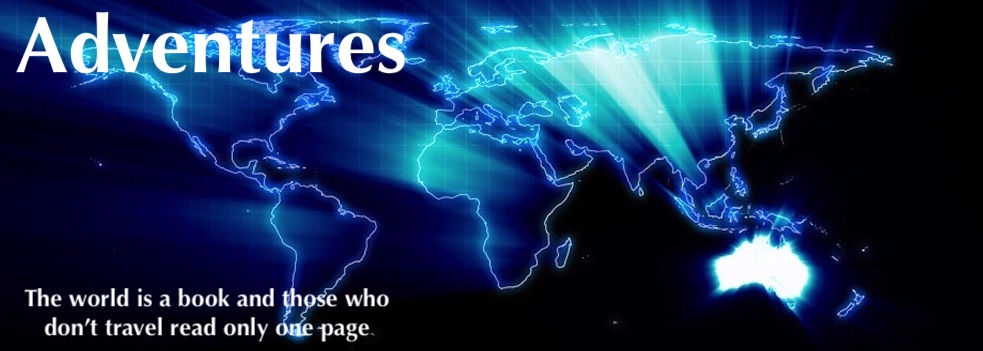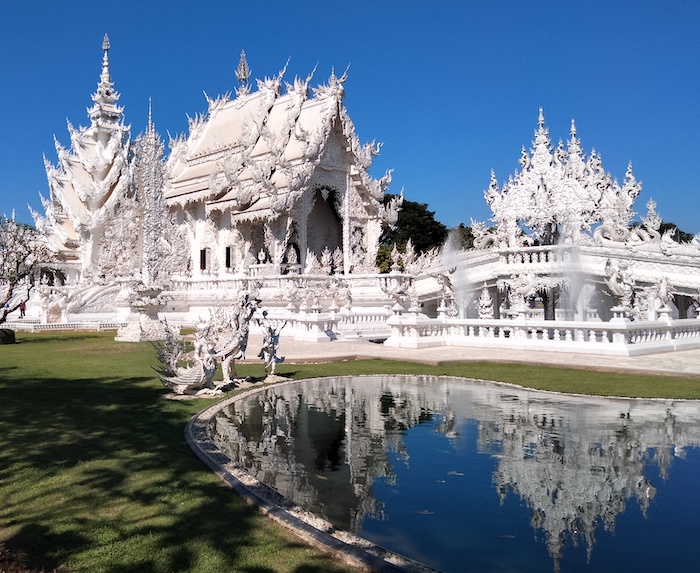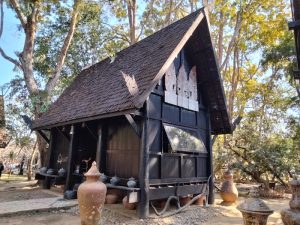Tourism by Colours – White Temple, Golden Wat, Blue Wat and the Black House/Museum
Our destination out of Chiang Mai was the world famous White Temple – more fomally, Wat Rong Khun.
- The magnificent White Temple.
What a huge change since my last visit in 2018! From a spectacular artistic creation the White Temple has transmogrified into a theme park.
Most visitors have no idea what they are looking at – and indeed don’t really look at it. And if they do look at it, they don’t care. As long as they have their photograph taken in front of the attraction! Most amusing is those who pose in front of the ornate golden structure. Do they realise it is the world’s fanciest-decorated toilet.
- World’s fanciest toilet.
I am certainly no arbiter of taste, no authority on Thai or any other architecture but my observation is that the overall result of the changes and additions to Thai artist Ajarn Chalermchai Kositpipat’s original amazing creation are plumbing the depths of bad taste.
- Wat Rong Khun Theme Park
Hordes of wide eyed ‘spectators’ arriving by the coach load is proof of the adage “build it and they will come” * regardless of how crass the attraction.
It’s a pity. We took some happy snaps and left.
Golden Temple
Located on the edge of the White Temple Theme Park is a new structure with cleaner lines. Quite spectacular.
- Tacked onto the edge of the Theme Park like an afterthought.
Blue Temple
Next on the agenda was an equally crass creation. A Wat (temple) painted blue to give it a point of difference and hopefully attract the tourists. And in that it is reasonably successfully. The wat has the usual nagas, spires, points and features of countless Thai temples but this one allows you to be bored in blue.
We took a few happy snaps and left feeling fortunate that we weren’t on an organised tour with a pre-allocated amount of time to ‘absorb the culture’.
Black House
Next on the colour chart was the Black Museum (although to be precise black is an absence of colour) that has garnered good reviews.
- The Black House – looking slightly red.
The Black House presents itself, basically, as art. It is an eclectic collection of objects subjectively presented as a museum. The concatenation of various displays and creations asks the question, “what is this all about?’. A neutral reaction is not possible and if that was the creators’ intention then they have succeeded.
If there is a theme, apart from chairs made from buffalo horns and hide, it is difficult to discern. Some of the displays look like a mad women’s breakfast. Others look like an attempt at religious engraving but fall short – projecting an aura that something is not quite right.
To be fair to the experience we visited each of the display buildings in the complex and had no regret in leaving after having eyeballed it all.
It was time to move further north. Perhaps less colourful, hopefully more substantial.
Chiang Saen – Ancient Capital on the Mekong
Chiang Saen on the Mekong River is an ancient city dating back to 1327 and possibly earlier.
Frans Betgem has written extensively on the ruins of Chiang Saen and his work is well worth a read. His assertion that Chiang Saen Old Walled City should have World Heritage status has merit.
Golden Triangle
The ‘physical Golden Triangle’ is where the Ruak River flows in the Mekong River and the borders of Thailand, Laos and Myanmar meet.
The Golden Triangle of not too long ago was a large area in Thailand, Burma and Laos where opium cultivation thrived from the 1950s although production of this illicit crop dates back centuries. Efforts by the Thai government to improve roads, develop tourism, and encourage alternative crops gradually got on top of the problem and by the 1990s opium production was effectively thwarted (in Thailand anyway) and the Golden Triangle is now only a legend used to spice up tourist brochures.
The tourist development at Ban Sop Ruak around the Golden Triangle marker (markets, restaurants and homestays) is minuscule in comparison to what is occurring on the opposite side of the river in Laos.
- Construction work in the Golden Triangle SEZ has been booming since 2007.
The Golden Triangle Special Economic Zone was created in 2007 by the Lao government together with the Chinese company Kings Romans Group to ‘generate economic development’. It quickly gained a reputation of being a Chinese enclave rife with illegal activities such as human trafficking/slavery, child prostitution, drug trafficking and wildlife trafficking.
As the vestiges of the day were fading we headed back to Chaeng Saen, away from the Ban Sop Ruak tourist trap to find accommodation and somewhere to eat.
Our trip from Chiang Mai to the Golden Triangle covered 270 kilometres through two Provinces (Chiang Mai and Chiang Rai).
* The actual quotation from the 1989 movie Field of Dreams is, “If you build it, he will come”.
Go to Chiang Saen to Na No
Go back to Around Chiang Mai
Go to Northern Thailand Overview
© Kim Epton 2024
877 words, 23 photographs.
Feel free to use any part of this document but please do the right thing and give attribution to adventures.net.au. It will enhance the SEO of your website/blog and Adventures.
See Terms of Use.























